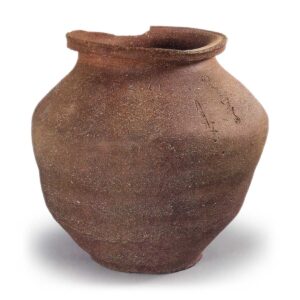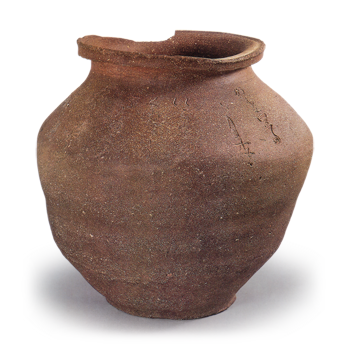
Excavated near the mouth of the Yura River, Kyoto
Marked “Kagen 4 (1306)
Height 34.3cm, mouth diameter 23.5cm, body diameter 37.4cm, bottom diameter 16.6cm
Important Cultural Property
This is one of the few rare examples of Echizen pottery for which the date of production can be determined from the inscription on the shoulder. The inscription is written in nine lines in cursive,
Kagen 4 (4th year of Kagen)
August 17
Echizen no kuni
Niu no Kuni
Kita no ko’ori (Northern county)
Ota-no-shiyau (Oda-no-sho)
Akata□ (Prefecture of)
Torakata
Unokamen (a jar of rice)
The name can be read as “Toragatayu”. The identity of Toragatayu is unclear, but the fact that it was excavated near the mouth of the Yura River in Tango, far from Oda-sho, Niu-gun, may lead to a variety of historical interpretations.
The clay is a sandy clay characteristic of Echizen pottery, and is very hard-fired, with a yellow natural glaze applied to the mouth rim and part of the shoulder in a sesame sprinkled pattern. The folded rim is N-shaped like that of the Tokoname ware, but the rim band is not as wide as that of the Tokoname ware of the same period. This is probably due to the hardness of the clay used for the vessel body, which is highly refractory. It shows a thick-walled and massive appearance.



